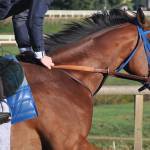Is Dietary Cation-Anion Balance Related to Tying-Up in Horses?

This study was designed to determine whether plasma, urine, and fecal electrolyte and mineral concentrations differ between clinically normal horses and Thoroughbreds with recurrent exertional rhabdomyolysis (RER) after consumption of diets varying in cation-anion balance.
The study used five Thoroughbred mares with RER and six clinically normal mixed-breed mares. Each of three isocaloric diets designated as low, medium, and high on the basis of dietary cation-anion balance (DCAB) values of 85, 190, and 380, respectively, were fed to horses for 14 days. During the last 72 hours, three horses with RER and three control horses had daily urine and fecal samples obtained by total 24-hour collection. Remaining horses had urine samples collected daily by single catheterization.
For each diet, no differences existed between horses with RER and control horses in plasma pH, electrolyte concentrations, and creatine kinase activity or in urine pH and renal fractional excretion (FE) values. Plasma pH, strong ion difference, bicarbonate and total carbon dioxide concentrations, and base excess decreased and plasma chloride and ionized calcium concentrations increased with decreasing DCAB. Urine pH decreased with decreasing DCAB. The FE values of chloride and phosphorus were greatest for horses fed the low diet. The FE values for all electrolytes except magnesium did not differ between urine samples obtained by single catheterization and total 24-hour collection. Daily balance of calcium, phosphorus, sodium, chloride, and potassium did not differ significantly among horses fed the various diets. In clinically normal horses and in horses with RER, the DCAB strongly affects plasma and urine pH and the FE of sodium, potassium, chloride, and phosphorus.
This report of KER’s 2002 research was published in American Journal of Veterinary Research.
Read the entire research report, titled Plasma and Urine Electrolyte and Mineral Concentrations in Thoroughbred Horses with Recurrent Exertional Rhabdomyolysis After Consumption of Diets Varying in Cation-Anion Balance.








